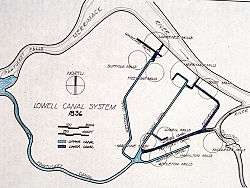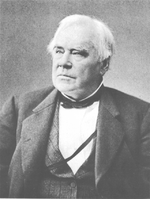James B. Francis
James Bicheno Francis (May 18, 1815 – September 18, 1892) was a British-American civil engineer, who invented the Francis turbine.
| James B. Francis | |
|---|---|
|
James Francis, around 1887 | |
| Born |
May 18, 1815 South Leigh, Oxfordshire , England, United Kingdom |
| Died | September 18, 1892 (aged 77) |
| Nationality | British-American |
| Fields | engineer |
Early years

James Francis was born in South Leigh, near Witney, Oxfordshire in England, United Kingdom. He started his engineering career at the early age of 14 as he worked as his father's apprentice at the Port Craw Railway and Harbor Works in South Wales.[1] When he turned 18, he decided to emigrate to the United States, in 1833. His first job was in Stonington, Connecticut as an assistant to the railway engineer George Washington Whistler Jr., working on the New York and New Haven Railroad. A year later, James and his boss, Whistler, travelled north to Lowell, MA,[2] where at the age of 19, he got a draftsman job with the Locks and Canal Company, and Whistler became chief engineer.
A few years later, in 1837, G.W. Whistler resigned, and went to work on Russia's major railroads. Before departing, Whistler appointed Francis to Chief Engineer, and sold him his house on Worthen street. That same year, James married Sarah W. Brownell in Lowell on July 12, 1837.[3] Their first son, James Jr. was born March 30, 1840, and then they had five more children.
In 1841 came his first major project for the company. Francis was to analyse how much water each mill factory was using from the company's channel system. Impressed by his abilities, the company named him "Manager of Locks and Canals" in 1845.[1]
As Manager & Chief Engineer, Francis was responsible for the construction of the Northern Canal and Moody Street Feeder. These two canals, built in the late 1840s and early 1850s, completed the 5.6 mile long Lowell canal system, and greatly increased its industrial power of the thriving industrial city's mill complexes.
During his work on the Lowell systems, James was also consulted on many other water projects nationwide. When New York needed to increase their water supply, he consulted on the construction of the Quaker Bridge Dam on the Croton River in New York. He also consulted on the dam at Saint Anthony Falls on the Mississippi river.[1]
Their son James fought in the American Civil War as a 2nd Lieutenant in 1861. He was wounded in the hand at the Battle of Antietam as a Captain, and finished the war in July 1865 as Lieutenant Colonel.[4]
Fire sprinkler system
In 1845, James Francis developed the first sprinkler systems ever devised in the United States. On top of Lynde Hill, in the Belvidere section of Lowell, he had a 2,000,000-gallon reservoir constructed with a 36-inch-diameter (910 mm) underground cast-iron branch mains connecting to several mills. The first simple gravity system was first implemented at the Suffolk Mill Picker Houses. About twenty years later, in 1869, Francis contracted Frederick Ginnell of the Providence Steam and Gas Pipe Company to install a "perforated pipe" system invented in England by John Carney in 1906, to work with Francis' system. The two became friends, and shared and tested many ideas. Their systems also became very popular with the mill owners and insurance companies, and the Providence Steam and Gas Pipe Company began installing similar systems throughout the mills in Fall River, Massachusetts and elsewhere.[5]
The Francis system was simple: Valves would be opened manually, allowing water to flow through an array of pipes tucked close to ceilings, and ending with small jets spraying the water. The big issue was that this sprinkler system was throughout the entire building, so any use of the system would flood the entire structure and all its contents. It was not until 1875, that Henry Parmelee invented a sprinkler head that only activated one at a time, and that is when sprinkler systems became very popular.[5]
Turbines
James also became fascinated with and tinkered with turbine designs, after Uriah A. Boyden first demonstrated his Boyden turbine in Lowell. The two engineers worked on improving the turbine. And in 1848, Francis and Boyden successfully improved the turbine with what is now known as the Francis turbine. Francis' turbine eclipsed the Boyden turbine in power by 90%. In 1855, Francis published these findings in the "Lowell Hydraulic Experiments".[6]
Flood control
In 1850, he also ordered the construction of the Great Gate over the Pawtucket Canal to protect the downtown mills from any devastating floods. This project quickly became known as; "Francis' Folly", for no one believed it would work, never mind that it may ever be needed. But, less than two years later, in 1852, the gates saved the city of Lowell from the devastating floods of 1852, then again in; 1936, 1938, 2006, and 2007 by preventing the Merrimack River from entering the canal system. However, arson damage to the wooden gate in the 1970s, and the difficult method of dropping it (by breaking a large chain link) prompted the city to use a more modern steel-beam bulkhead in its place in 2006. For his efforts in saving the city from great disaster Mr. Francis was awarded a massive silver pitcher and a salver by the City of Lowell.[7]
In 1886, James B. Francis, teamed up with two other civil engineers; Eliot C. Clarke and Clemens Herschel to study and publish their findings in the "Prevention of Floods in the Valley of Stony Brook" which laid out a flood prevention system for the city of Boston. The intense study reviewed the Forest Hills, Hyde Park, Franklin park and Roslindale sections of the city that were subject to flooding.[8]
In 1889, Francis was also called to duty as a member of the commission to examine the cause of the Johnstown, PA disaster, when the South Fork Dam broke, killing over 2,200 people.[7]
Later years
Francis stayed active on all levels of involvement in the city of Lowell, and even served as an Alderman from 1862 to 1864.[9]
In 1865, James researched and publish his findings on cast iron, and their use as structural columns in; "The Strength of Cast-Iron Columns."
Francis also originated scientific methods of testing hydraulic machinery, and was a founding member of the American Society of Civil Engineers and its president in 1880.
In 1883, James completed his calculation standards for water flow rates, now known as the Francis equation or Francis Formula, usually used in Fluid Dynamics in conjunction with calculating weirs.[10] Q=3.33h1 3/2 (L-0.2h1)
Q= discharge in ft3/s neglecting velocity of approach
L =the length of weir in feet
h1= head on the weir in feet
He remained at the Locks and Canal Company for his entire career, until retirement in 1884 at the age of 69, and remained on as a consultant right up until his death. His son James took over as Chief Engineer. The rest of his life he spent with his wife Sarah, and their six children in their home on Worthen Street, which was Whistlers old home and now the Whistler House Museum of Art. Francis died on September 18, 1892, at the age of 77, and is buried at Lowell Cemetery under a massive pillar of cut granite stones, symbolizing the stones used to make the canals.[11]
Honors
For all his contributions to the world of engineering and personal generosity, the following are named in his honor:
- James B. Francis College of Engineering at the University of Lowell; Masters, Ph.D and D.Eng. Engineering degrees and research in over seven Engineering programs, including Plastics and Nuclear Engineering.[12]
- Francis Gate, Lowell MA.
- Francis Turbine.
- Francis System; an early fire protection sprinkler system.
- Francis Formula; describes water as it goes over dams. it is used today in fluid mechanics as an equation for the calculation of water flow rate over a rectangular weir in terms of length and head.
Notable uses of the Francis turbine

Today, the Francis Turbine is the most widely used Water turbine in the world, including China's new Three Gorges Dam as the world's largest hydroelectric power station in the world, with a future installed capacity of 22,500 MW. With the incorporation of the Francis turbine into almost every hydroelectric dam built since 1900, it is responsible for generating almost 1/5 of all the worlds electricity:
- Älvkarleby Hydroelectric Power Station 1911, in Sweden - early hydroelectric plant in country
- Hoover Dam 1936, Nevada/Arizona - 2,080 MW, world-renowned and once the largest hydroelectric power station in the world
- Grand Coulee Dam 1942, in Washington - 6,809 MW, largest power station in country
- Dez Dam 1963, in Iran - 520 MW, major project in country at time of construction
- Gordon Dam 1978, in Tasmania - 432 MW, tallest dam in country
- Dalešice Hydro Power Plant 1978, in Czech Republic - 480 MW, tallest dam in country
- Nurek Dam 1980, in Tajikistan - 3,000 MW, tallest dam in the world
- Robert-Bourassa generating station 1981, in Canada - 5,616 MW, largest power station in country
- Itaipu Dam 1984, in Brazil/Paraguay - 14,000 MW, largest power station in the Americas
- Victoria Dam 1985, in Sri Lanka - 210 MW, tallest dam in country
References
- 1 2 3 Lowell National Historic Park publication
- ↑ Encyclopaedia Britannica
- ↑ http://ma-vitalrecords.org/MA/Middlesex/Lowell/MarriagesF.shtml
- ↑ http://reocities.com/Pentagon/2126/officers.html
- 1 2 THE EARLY HISTORY OF GRINNELL CORPORATION AND THE FIRE SPRINKLER INDUSTRY, Compiled By; Jerome S. Pepi Vice President, Research and Development Fire Protection Products, January 25, 1996
- ↑ http://www.whistlerhouse.org/history_residents.php
- 1 2 Appletons' annual cyclopaedia and register of important events, Volume 17
- ↑ "Prevention of floods in the valley of Stony Brook: a report by a Commission" By Boston (Mass.). Stony Brook Commission, James Bicheno Francis
- ↑ Contributions of the Old Residents' Historical Association, Lowell ..., Volume 1 By Old Residents' Historical Association of Lowell (Mass.)
- ↑ http://www.usbr.gov/pmts/hydraulics_lab/pubs/wmm/chap07_09.html
- ↑ http://www.nps.gov/lowe/historyculture/upload/JB%20Francis_%20Lowell%20Notes.pdf
- ↑ http://www.uml.edu/college/Engineering/
Bibliography
- Layton, Edwin T. "From Rule of Thumb to Scientific Engineering: James B. Francis and the Invention of the Francis Turbine," NLA Monograph Series. Stony Brook, NY: Research Foundation of the State University of New York, 1992.
- Francis Obituary in Engineering News, Volume XVII, January-June 1887, page 14.
External links
| Wikimedia Commons has media related to James B. Francis. |
| Library resources about James B. Francis |
| By James B. Francis |
|---|
